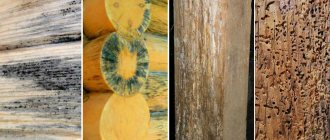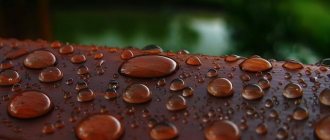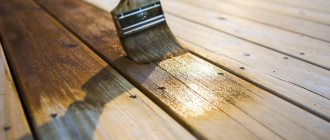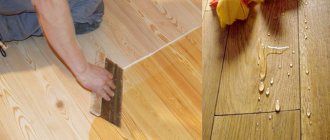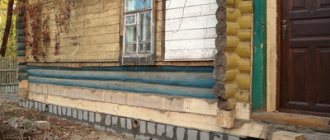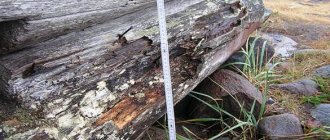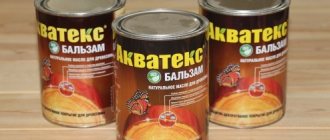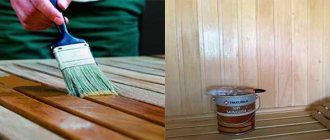Construction and finishing materials, furniture made from different types of wood are valued at any time. Wooden structures retain heat well, have natural beauty and are environmentally friendly, and provide protection from noise. But many of the advantages of wood are downplayed by a major drawback - weak resistance to negative environmental influences. The tree is affected by insects, moisture, fire and other external factors.
To protect wooden products from various types of destruction, special protective compounds are used. Each protective product is designed taking into account the place of application and purpose. The structure of the material acquires properties that can extend its service life many times over. Depending on the composition of the product, the surface of the material either acquires a protective film, or the wood structure is completely impregnated. The article will consider: the best impregnation for wood in 2022; types of protective equipment; appointment; advantages and disadvantages.
Why is wood protection necessary?
The popularity of wood as an environmentally friendly material used in a variety of fields attracts both large manufacturers and ordinary users.
But wood has one feature that is worth considering. It is weakly resistant to moisture and decay, therefore it is subjected to special treatment. Before you start working with this natural material, you need to find out why wood needs protective manipulation by humans.
- Wood is a material that does not tolerate contact with moisture well. Most rocks begin to quickly become wet and deteriorate because of this, soon undergoing the process of rotting.
- Often wooden boards suffer from sudden temperature changes. They may begin to warp and become deformed.
- Wood can be seriously damaged by attacks from various wood parasites - beetles. They devour natural material, which is why its quality quickly decreases.
- Wood is also susceptible to fungal growths. The same mold, which often forms in conditions of high humidity, greatly spoils the quality and condition of the environmentally friendly material.
- The most dangerous thing for wood is contact with fire. The material not only ignites very easily, but also actively supports the flame.
To prevent all of the above factors from spoiling or completely destroying the natural material, specialized products are used that reliably protect the wood. After the treatment procedure, its performance characteristics and resistance to negative external influences increase sharply. The service life of wood increases noticeably, as does the service life of structures made from it.
Tips from professionals for choosing impregnation
Before you start choosing a protective composition, you need to consider some subtleties:
- Water-based impregnations require high-quality drying to avoid deformation and cracking of the material.
- Water-based impregnations are suitable for both external and internal work.
- When choosing impregnation, it is important to consider the type of wood. For example, alder or aspen are not resistant to decay, and therefore require deeper and more thorough processing. On the contrary, oak or ash have a high degree of resistance to parasites, so to protect them it is enough to treat them with one complex impregnation, which will create several layers of protection: from fire, from parasites, from moisture and rot.
- It is also important to consider that each type of wood has a different density and degree of “absorption” of the material. Spruce and oak are very difficult to impregnate and require several layers of aqueous antiseptic composition, while pine and birch literally “absorb” only the applied layer of protection.
- Be sure to familiarize yourself with the degree of toxicity of the impregnation and clarify whether it is recommended for use indoors.
Before choosing, it is important to decide what effect you expect from impregnation. That is, what functions it should perform: protect against fire, water or parasites.
At the same time, consider whether you need decorative wood decoration. If not, there are many clear bases available on the market for processing. Otherwise, there is decorative impregnation of various shades.
Processing options
Protection of wood from fungus is carried out using a number of pre-conducted preventive measures. Choose one option or another based on the budget and operating conditions of the structure.
In construction stores there are different versions of such products available - both in the form of a solution and in the form of a paste. Protection should be applied not only to the wooden surface, but also to places in contact with the ground. The depth of impregnation is about one and a half meters. A solution of potassium dichromate (5%) or sulfuric acid (5%) is best suited. Novotex, Pinotex, Biokron and Biosept are antiseptics that are completely ready for use.
Only certain groups of antiseptics and impregnations are suitable for treating wood in the ground. Make sure that the product is moisture resistant, since underground the material is more susceptible to salt and moisture. It is necessary to cover with this preparation all surfaces of the structure that are exposed to precipitation.
Users often search for:
- Impregnations for wood
- How to paint a gazebo
- Wood protection for outdoor use
There are artificial and natural drying. The first option is carried out using petrolatum or storing wood in special chambers with elevated temperatures. The process occurs quickly: the time varies from one hour to several days, and the fungus dies under such conditions.
Natural drying is a more suitable option for doing it yourself. The wood is left under a canopy in the open air or stored in a well-ventilated area. The process takes a lot of time: from one week to several months, but this method does not require large material costs and guarantees reliable protection of the material.
A high foundation ensures a long service life of a wooden structure
Using antiseptics for wood processing
If we give a comparative description of varnishes and antiseptics, then the use of the latter is more profitable financially. In addition, varnishes and paints do not remove existing stains, but only preserve them. Antiseptic compounds eliminate those that already exist and prevent the appearance of new ones.
How to choose treatment products
The antiseptic market is filled with products from both foreign and domestic manufacturers. The former are more expensive, but do not always guarantee quality. Which composition to choose is decided only by the buyer, based on his own preferences, characteristics of the drug and financial capabilities.
In Russia, it is worth paying attention to Sarus products. It not only gets rid of existing rot, but also prevents new fungal colonies from appearing. An important advantage is the low price.
If rot covers a significant part of the surface, you should pay attention to the drug Neomid 500. The good power of the drug is “compensated” by its high price. Among cheaper analogues with the same characteristics, the drug Liga Bioshield stands out.
To treat very rotten areas, water-based Senezh products are used, which penetrate deeply into the structure of the tree. They are recommended for both primary and re-processing, and for work in damp, cool places, such as cellars. The only exception is that surfaces should not be painted with oil paint. When choosing a drug from a series, consider the specific task.
The drug Drevosan Profi will help prevent the development of putrefactive processes. Recommended for processing fences, window frames, and small architectural forms. An additional advantage is the death of not only mold and rot, but also insects that destroy the wood from the inside.
Do you want to save money and buy one product for both exterior and interior work? Invest in the antiseptic Bitsidol-100. An important advantage is that the composition not only forms a protective film on the surface, but also penetrates the wood structure without changing it. During the entire period of operation, the tree will be under reliable protection from both water and fire. Disadvantage - the color of the wood will change to green. If you want to avoid this, pay attention to the modification of the drug "Bicidol-500". Preservation of the original color is guaranteed.
You should choose a treatment product only after carefully studying the technical characteristics, composition, principle of action and side effects. No less important is the method of application - using a brush or spray bottle. Some formulations require that the product must be completely immersed in the solution.
If you do not follow the manufacturer's recommendations, you will have to replace damaged or damaged parts of the interior or facade.
Expiration dates of drugs
The combination of constant humidity and high temperatures creates favorable conditions for the appearance and development of rot. A high-quality drug will delay this moment for 12 years or more. Antiseptics protect against both fungus and fire. The maximum validity period is no more than 7 years. Water-resistant compounds are intended for treating buildings, design elements, and fence posts. Then for 30 years or more you won’t have to worry about repairs or replacements. Ideally, the drug contains components that protect against cracking.
Don't buy random products. Read the manufacturer's instructions and consumer reviews. Careful selection is a guarantee of getting rid of mold and rot. Preliminary cleaning of existing stains of rot, dirt, paint or varnish will help to enhance the effect of any drug.
How does protection against moisture and rot work for wood?
It was already mentioned above that one of the reasons for the development of rot is high humidity. In some cases this is a consequence of precipitation, and in others it is a natural condition for a particular area (for example, coastal areas). In any case, the number one task to prevent rot is to protect the wood from external moisture. How to treat wood against rotting and moisture? To do this, you can purchase special preparations sold in hardware stores.
They are applied to the surface and make it water-repellent. Water falling on the walls of the house will immediately roll down, rather than remaining on the wood, gradually being absorbed and leading to the development of rot.
Some of them are applied comprehensively and have higher efficiency and durability. Others are applied one at a time - this is cheaper and takes less time. But their service life is noticeably shorter.
Impregnation technologies
Do-it-yourself hydrophobic impregnations for wood are applied to surfaces in various ways, but the most commonly used method is the smearing method and the soaking method. You also need to take into account that impregnation can be applied to wood only after preliminary surface treatment.
Preliminary stage
Water-repellent impregnation is applied only to the treated surface. Processing algorithm:
- If the wood has an old coating (impregnation, paint, etc.), then it needs to be removed. This can be done using a spatula or a wire brush. If the old paint is very difficult to remove, then it must be preheated with a hair dryer.
- Now you need to sand the surface to make it smooth. It is recommended to do the treatment 2 times - with coarse and fine sandpaper.
- Finally, use a rag to remove dust and various construction debris.
Preparation of the oil-wax mixture
Impregnation is done as follows:
- Take the wax and grate it on a coarse grater.
- Pour oil into a large metal container and place it on the fire.
- When black smoke appears, add the grated wax and stir the mixture with a stick.
- When the wax is completely dissolved, turn off the heat.
- When the solution has cooled slightly (to +60 degrees and below), pour it into a glass jar.
The ratio of oil and wax should be:
| Oil | Wax | What can be processed |
| 8-10 parts | 1 part | Floors, thin surfaces and woodwork |
| 3-5 parts | 1 part | Walls, thick surfaces and large woodwork |
| 1 part | 1 part | Ceilings and thick walls |
Coating
Coating is used to protect large objects and/or surfaces (walls, ceilings, doors, large furniture, etc.). Algorithm:
- Take a jar of oil-wax mixture and stir it with a stick.
- Using a brush, apply impregnation to the wooden surface (it is recommended to apply the composition along the grain).
- 20 minutes after application, carefully remove excess impregnation with a rag.
- Wait until the impregnation dries completely (in the case of tung oil - 1-2 days, in the case of linseed oil - 2-3 days, and so on).
- If more durable protection of wood from rotting is required, then after drying you need to apply another 1-2 layers according to the standard algorithm.
Soaking
Soaking is suitable for impregnating small items (toys, wooden dishes, decorative items, etc.). Theoretically, it is possible to soak large removable surfaces and products, but this will require a large container, and the consumption of the composition will be very large. Algorithm:
- Lay several layers of newspaper or protective paper on the floor.
- Place a large metal container and fill it 50-60% with the oil-wax mixture.
- Place wooden products there for 1 day.
- Remove the products from the container and place them on newspaper or paper (it is recommended to place them on some inclined surface to allow the oil to drain).
- Wait for the impregnation to dry.
- If necessary, after complete absorption and drying, repeat the procedure again.
No. 4. Products for protecting wood from moisture
An increased level of humidity is the main enemy of wood, as it not only impairs performance, but also causes the appearance of mold and mildew. Treatment aimed at protecting against moisture begins with wood harvesting, and proper drying is of great importance. Even well-dried material will begin to absorb moisture over time, but in this parameter, different types of wood differ greatly. Larch, ash, pine, oak are more resistant to moisture, spruce, fir and beech are moderately resistant, and maple, birch and hornbeam are the most vulnerable. A number of tropical trees (kumaru, cousia, ipe, sisal) are practically not afraid of moisture and require only minimal protection.
The most important indicator of wood is intracellular moisture. For construction, you can use a material with a moisture content of 5-20%, and wood with a moisture content of 9-15% is suitable for truss structures and interior decoration, and 12-18% for exterior cladding.
To reduce the ability of wood to absorb moisture from the environment, i.e. To reduce its hygroscopicity, varnishes, oil impregnations and pastes are used, which are divided into two groups:
- the compositions that form a film on the surface are not durable enough, so the treatment will have to be repeated quite often;
- penetrating compounds are more durable and are able to penetrate the pores of wood; they are used to treat fences, window frames, house walls, and garden furniture.
As a rule, water repellents do not change the color of wood, and their effect is that drops of water simply roll off the surface without penetrating into the structure. A number of such products also have a frost-resistant effect.
Purpose of water-repellent impregnation
Water-repellent impregnation is a special substance that coats the surface to increase its protective properties. As such impregnation, special mixtures that are sold in stores are usually used. There are both internal and external wood impregnations, as well as universal ones. You can also make protective impregnation yourself at home using oil and wax.
Wood impregnation performs the following functions:
- Protection from water and precipitation. Wood can absorb water on contact, resulting in poor performance.
- Protection from harmful bacteria. In case of prolonged contact with water, pathogenic microorganisms can settle in the wood and begin to destroy such a product from the inside, and the main danger is that such bacteria are almost impossible to destroy.
- Protection from bugs and mechanical damage. Bark beetles have powerful jaws, and they usually live in large colonies, so they can very quickly destroy wooden products.
How to treat wood with anti-rot impregnations?
It is best to apply water-repellent wood impregnation in dry and warm weather. Before applying the anti-moisture and rotting agent, the surfaces to be treated must be thoroughly cleaned, since contamination prevents normal adhesion and full penetration of the composition into the structure of the material.
To obtain the best effect, it is important to follow the proportions recommended by the manufacturer (if the product requires dilution).
When applying antiseptic compounds it is recommended:
- Apply water-based and other low-viscosity glazes with a spray gun, and thicker ones with a brush or roller.
- Take into account the drying time of the selected impregnation - it depends on the type of product.
- For internal use, choose environmentally friendly compounds that are absolutely safe for people and pets.
- Apply as many layers as recommended by the manufacturer.
- Repeat the treatment at the frequency specified in the instructions - weak saline solutions are applied annually, and heavy resinous solutions last for several years.
- Use the purchased azure strictly for its intended purpose.
- Familiarize yourself with the rules for using antiseptics and strictly follow them.
Recommendations for the selection and use of wood impregnations
Impregnation should provide reliable protection of wood from rotting, fungal infections and biological destruction, but at the same time be absolutely harmless to people, animals and the environment. These are the tools it offers. Impregnations from our catalog:
- have a natural plant composition, so they can be used for interior woodwork without the slightest risk;
- provide excellent results for a long period of time;
- easy to apply;
- penetrate deeply into the wood structure;
- form a reliable water-repellent barrier;
- improve the performance characteristics of the material and protect it from the negative influences of the external environment.
What happens if you leave a tree unprotected?
In any case, the consequences will be detrimental - this includes damage to the surface, deterioration in appearance, and a significant reduction in service life.
In regions with a humid climate, the lack of protection guarantees the appearance of fungi, moss, mold and rot, which will ultimately lead to either the need for major renovations in the next few years, or to the purchase of another home in the near future.
If you are lucky with the climate and dry, hot weather protects against putrefactive processes, the decorative effect suffers.
LeikyFORUMHOUSE Member
There is a rather old and unkempt country house. The condition of the walls is as in the photo. I want to paint it to make it look better, but I've never done it. Tell me how best to prepare the surface for painting, and what paint to choose in order to leave the wood texture or, with such initial data, just cover it with opaque paint (green, brown, beige)? I thought about foaming the cracks, then going through it with a drill and a wire brush, and then sanding it around. Then cover with an antiseptic or is paint enough?
In this case, you can get by with putting the facade in order.
Technical Specialist
It is not recommended to foam all cracks; it is better to use special materials - sealants designed for sealing cracks. It is also better to treat the ends with special materials. Next, sand the surface, apply a water-based primer with high penetrating power and apply a topcoat. You can emphasize the texture using water-based glazes, for example, with a natural graying effect.
Types of wood protection products
When choosing liquids to protect wood from moisture and rotting, consumers pay attention to its high efficiency. But, besides this, the substance must not be harmful to human health.
Most often, solutions that affect the durability of wood and can protect it from negative factors are quite dangerous.
It is absolutely necessary to ignore compounds containing tin and zinc compounds. These are the most toxic chemicals. Let's take a closer look at how to treat wood to protect it.
Decorative impregnation
Protecting wood from rot and water is the main task of moisture-resistant impregnation. The material processed with this composition is used to build baths, fences, basements, gazebos, etc. They are used both individually and in combination with bioprimers. The last substance must be treated with the boards before painting.
The essence of impregnation lies in its deep penetration into the structure of the wood and in this way clogging its pores. When treating wood with a solution, the penetration of moisture into the wood structure is limited. But besides this, impregnation colors wooden products and in this way gives them a noble appearance.
Oil based product
To prevent rotting, covering the boards with an oil-based product is necessary when using them externally. Protection of the board from rotting is ensured by the film formed after applying the product to the surface. Moreover, the resulting film on wood soaked in the solution does not allow water to be absorbed, and, therefore, prevents the fungus from penetrating into the wood structure.
The disadvantage of this product is the fact that a film forms on the surface, and it is not capable of protecting the tree from the effects of the fungus that already lives inside. The liquid composition of the impregnation is almost non-toxic, so it is used to cover wooden elements in houses where people live.
Water-based impregnation
Also, to protect wood from moisture, impregnation is used, which is well diluted in water. It is absolutely safe, there is no pungent odor when working with it, and it dries quickly. Water-soluble impregnations are used to prevent wood rotting and fungal penetration. Despite this, this composition is not recommended for use in rooms with high humidity. For example, when building a bathhouse, sauna or cellar.
The components of such solutions are boric acid, zinc chloride and sodium fluoride. They are better suited for wood, which is used in making furniture, making door openings, window slopes or frames.
Volatile based product
You can treat wood against rotting using means that have an easily volatile substance. The production of compositions is based on the addition of a certain substance to the coloring compositions, such as a solvent. Products of this type are not able to penetrate deeply into the structure of the wood, but at the same time they create a film whose strength is quite high.
Due to its volatility, the composition is best used for outdoor work, but it can also be used for interior wood processing indoors. The disadvantages of volatile agents include the long drying time of impregnating materials.
Oil or wax
The best substances for impregnating wood against fungus and mold are oil and wax. These substances have been used for more than 500 years, so their effectiveness has been proven in practice. Many people use either oil or wax for impregnation, but experienced craftsmen prefer to use these substances together as part of a complex impregnation. Wax impregnation with the addition of oil perfectly protects wood from moisture, mold, fungi, bacteria and light mechanical damage, but at the same time they are completely safe for humans. It should be borne in mind that there is only one type of wax, but oils are different, but most often tung, teak, tar and linseed oil are used for impregnation.
No. 8. Sequence of application of protective agents
To ensure maximum safety of the wood, it is treated with protective agents in the following sequence:
- antiseptics at the stage of procurement and transportation, as well as after the construction of the structure, furniture, organization of finishing;
- treatment with fire retardants if necessary;
- treatment with moisture-repellent impregnations, which will also prevent the leaching of fire retardant and antiseptic;
- applying paints and varnishes with ultraviolet protection;
- sealing joints and seams using acrylic sealant is an important process that prevents moisture from penetrating into the wood.
Popular wood impregnation products
Dufa
Contains adsorbents that perfectly fill all internal cavities of the tree. There have been cases when they tried to sheathe wood treated with this composition with clapboard - it was impossible to drive nails in properly! In addition, this product is relatively inexpensive.
Neomid
Domestic antiseptic impregnation, known for more than 20 years. Excellent for protecting facades, bath rooms and wooden floors. According to the manufacturer, it remains effective for about 5 years. Then you need to perform processing again. The main advantage is that with good quality, the price of the product is relatively low.
